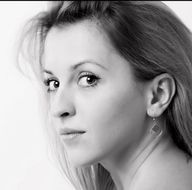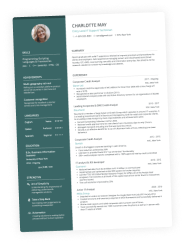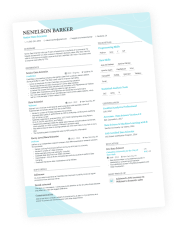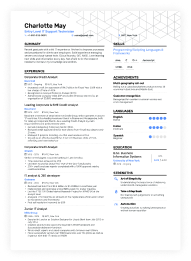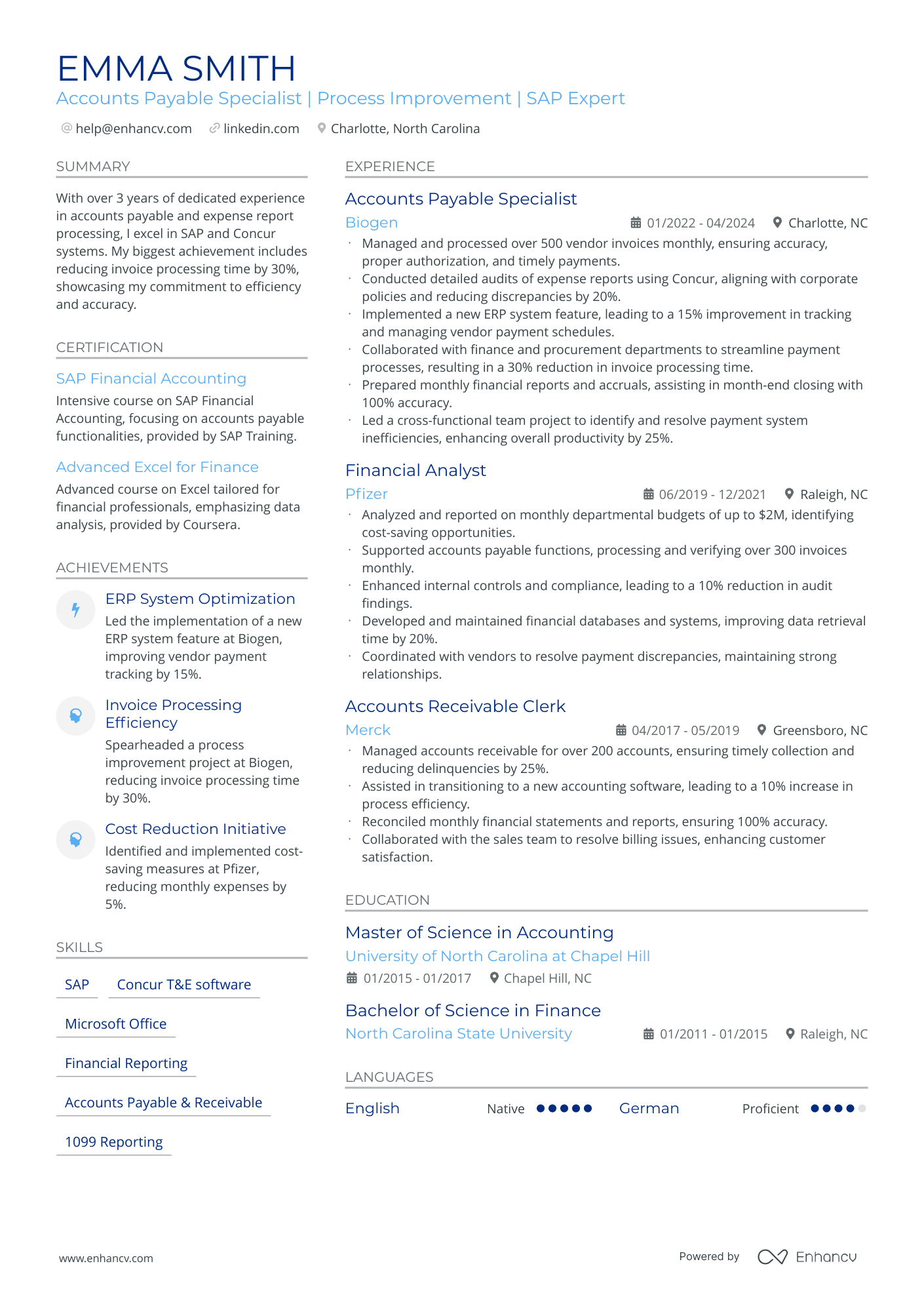If you’re reading this, chances are you’re new to resumes. In the industry, we don’t really talk about “personal resumes” because, in a way, every resume is personal—it tells your story.
However, at the start of your career or when you want to have one ready for unexpected opportunities, a simple, well-structured document with key personal information can open doors.
This guide will walk you through the evolution of a personal resume into a professional one, show you how to write yours, and provide examples to help you create a resume that fits your goals.
Key takeaways
- A personal resume is a flexible, creative way to organize your experience—ideal for students, freelancers, and career changers.
- You don’t have to follow traditional formats. Choose a layout that reflects your goals and showcases your skills in context.
- Projects, achievements, and soft skills can shine just as brightly as formal job experience—especially when framed with action and impact.
- Design and language matter: be intentional with your tone, visuals, and word choices to make your story stand out.
- Personal resumes can evolve into professional ones—start simple, make it yours, and keep refining as your career grows.
Let’s start with the basics.
What is a personal resume?
A personal resume is a flexible draft of your professional one. It’s not an official resume type, but rather a way to organize your personal information, experiences, and skills before you need a polished job application. If you’re new to resumes, the term might be confusing—after all, it’s not something employers specifically ask for.
Alternatively, a professional resume is exclusively structured for hiring managers and applicant tracking systems (ATS). It’s designed to highlight your work experience, skills, and achievements in a way that fits industry expectations.
PRO TIP
ATS systems are software programs that help employers organize and filter resumes based on keywords, formatting, and structure. These systems help recruiters sort through large volumes of applications by ranking those that closely match the job description.
A personal resume doesn’t need to be ATS-friendly, but when applying for jobs, you’ll want to make sure your professional resume is formatted correctly so it’s easy to find and read.
We’ll show you how to do that later in this guide.
If you’re just starting out or want a document ready for unexpected opportunities, a personal resume can help you get your experience down on paper. In the next sections, we’ll show you how to create one and turn it into a job-winning resume when the time comes.
Personal resume vs. professional resume
| Feature | Professional resume | Personal resume |
|---|---|---|
| Purpose | Job applications | Personal branding, creative expression, and volunteering roles |
| Tone | Formal and industry-specific | Flexible, can be informal |
| Content | Work history, skills, quantified achievements | Personality, soft skills, passion projects |
| Format | Chronological, functional, hybrid | Narrative, portfolio-style, mixed-media |
When do you need a personal resume?
Unlike a standard resume, which is designed for job applications, a personal resume gives you more freedom. It allows you to organize your knowledge and projects in a way that reflects who you are—even before you have a traditional career path.
Best use cases for personal resumes
- Personal branding: If you’re building a name for yourself online—whether as a writer, designer, or industry expert—your personal resume can highlight more than just your work history. It can focus on your values, mission, and unique approach to your field. Think of it as a document that helps you introduce yourself professionally, even outside of a traditional job search.
- Career changers: Switching careers? This resume type can help bridge the gap between where you are now and where you want to be. Instead of focusing on your past job titles, it can highlight your transferable skills, relevant side projects, and training in your new field.
- Creative industries: In fields like design, writing, or photography, a personal resume can be less rigid and more visually engaging. It can function as an extension of your portfolio, showcasing your work in a way that captures your personality and artistic style.
- Freelancers and entrepreneurs: When you’re self-employed, your experience doesn’t fit neatly into the "job title + company" format of a standard document. A personal resume allows you to demonstrate your services, client work, collaborations, and expertise in a way that makes sense for your business.
- Students and entry-level applicants: If you don’t have much work experience yet, a personal resume can be a great way to document your skills, achievements, and extracurricular activities before transitioning to a professional format. It helps you see what you bring to the table—even if you haven’t had a formal job yet.
So, do you need one?
If you're in any of these situations, a personal resume can be a helpful tool for organizing your experience and presenting yourself professionally—even before you land your next role. The key is knowing how to structure it so it can eventually evolve into a strong job resume.
Up next, we’ll show you exactly how to do that.
How to write a personal resume (a 6-step guide)
This personal format allows you to show what you’ve done, not just where you’ve worked. Whether it’s volunteer work, creative projects, freelance gigs, or leading a student club, a personal resume helps you put your experiences front and center—even if you don’t have a long list of past jobs.
Here’s how to build yours.
Step 1. Choose a resume format that matches your purpose
Many personal resumes look more like creative pitches than traditional job applications. They often break away from the standard US resume format, which follows a predictable structure:
- Header (name, job title, contact information)
- Summary or objective
- Work experience
- Skills
- Education
- Certifications
- Additional sections (optional)
More often than not, these sections appear in reverse chronological order, meaning your most recent experience comes first.
Here’s an example of a simple professional resume:
A personal resume, however, doesn’t have to follow this organization. The format you choose depends on why you’re creating it and how you plan to use it.
Here are a few common approaches:
Traditional layout (if applying for jobs)
If you’re using this as a stepping stone to a professional resume, it’s best to stick to a reverse chronological or functional format. This layout keeps things structured while allowing room for personal projects or non-traditional experiences.
It’s ideal for:
- Students or entry-level job seekers
- Career changers
- Anyone who wants an easy transition to a standard resume later
Portfolio-style resume (for creatives and freelancers)
For creatives, a personal resume can double as a portfolio, showcasing work instead of listing job titles.
This format may include:
- Links to projects or case studies
- Client testimonials
- A visual or interactive design
Narrative resume (for personal branding)
If you’re building a personal brand, a storytelling approach works best. Instead of listing jobs, this format focuses on your mission, values, and career journey—all the factors that shaped your expertise.
It’s especially useful for:
- Entrepreneurs and business owners
- Content creators and influencers
- Thought leaders and public speakers
PRO TIP
Not sure which format to choose? Start with a traditional layout and adapt it as your career evolves.
With Enhancv’s Resume Builder, you can create multiple versions tailored to different job opportunities—making it easy to adjust as your goals change.
Step 2. Add your contact information
This part is non-negotiable—every resume needs clear, up-to-date contact details. It’s how potential employers or collaborators can reach you.
Make sure to include:
- A professional email address (ideally some version of your name).
- A phone number with an active voicemail.
- Your city and state (full address not needed).
Only include details that present you in a professional light. Skip outdated usernames, personal blog links (unless they’re relevant), or social media profiles that don’t support your goals. That said, a nickname—if it’s commonly used or says something about your character or working style—can be a nice, original touch on a personal resume.
Step 3. Lead with a personal statement
Once you’re ready with the header, the next thing your resume needs is a personal statement—a short intro at the top that gives people a sense of who you are.
Even though you’re not applying for a specific job (yet), these three to five lines help tie your resume together. It’s your chance to say, “Here’s what I’m about, what I care about, and what I’m good at.”
You can think of it as a mix between a traditional summary or objective and the more casual, “social” feel of an About Me section you might find on a website.
Your personal statement should focus on:
- What motivates you.
- What you're good at or learning.
- The kind of work or projects you're excited about.
- Anything that reflects your personality and values.
It doesn’t need to sound formal or stiff. In fact, since this is a personal resume, you can let your tone be more human and reflective of your style.
Here’s an example:
Business student looking for entry-level opportunities
Curious and resourceful business student with a passion for digital marketing, storytelling, and making ideas stick. Currently learning SEO and building my first content strategy project.
A short statement like the one above sets the stage for the rest of your resume and makes it easier to read and understand.
Step 4. Focus on personal projects and achievements
Instead of a traditional work experience section, a personal resume gives you the chance to emphasize the projects, accomplishments, and roles that actually reflect your journey—whether or not they come from a formal job.
What you choose to include here depends on where you’re starting from and where you want to go. This part should show what you’ve done that’s relevant, impressive, or just very you.
How to frame your resume highlights
- If you’re a student, lead with academic achievements, school projects, club leadership, or something like earning your Eagle Scout rank. These all speak to your initiative and character—even if they weren’t paid roles.
- If you’re in the creative industry, highlight standout personal or freelance projects. Include a short description of what the project was, your role in it, and what made it successful. If you have links to your work, definitely add those.
- If you’ve done volunteer work or organized events, mention what you did, who benefited, and any results you can share (for example, raised funds, coordinated teams, grew attendance).
- If you’re teaching yourself something new, a side project can be proof of your curiosity and growth mindset. Whether it’s building a website, starting a blog, or launching a podcast—if it shows your skills or values, it belongs here.
For each entry, include one or two sentences that explain what the project was, what you contributed, and what impact it had. Focus less on job titles, more on action and outcome.
PRO TIP
On traditional resumes, it's common to avoid "I" to keep things concise and formal. However, on a personal resume, using the first-person pronoun is totally fine. It adds warmth and helps your voice come through.
Step 5. Amplify your skill set
A bullet-point list of skills can do the job—but a personal resume gives you the chance to do more than just drop buzzwords. This is your space to go beyond the basics and make your skills feel real, relevant, and a little more you.
Instead of only listing "team player" or "problem solver," bring your skills to life through action. Use vivid, specific language that gives the reader a sense of your working style. Active verbs like led, built, coached, adapted, designed, launched, reshaped, or navigated can tell a stronger story than did, made, or helped.
Don’t be afraid to use fresh adjectives either—words like curious, resourceful, strategic, empathetic, or detail-obsessed can go a long way in painting a more honest and memorable picture of how you work.
PRO TIP
Whenever you can, attach numbers or results to the skill. Think:
- Redesigned the student magazine layout, increasing readership by 35%
- Used AI tools to speed up the brainstorming process and reduce creative turnaround time by 50%
- Organized a fundraiser that brought in $4,200 for a local shelter
These little details don’t just make your resume more impressive—they make it more believable and memorable.
Ask yourself: Would someone else with the same skill say this the same way? If the answer is yes, try adding a verb, result, or context to make it stand out.
Here’s how good AI skills can be described in a personal resume:
AI Chatbot Project
Designed and trained a basic customer support chatbot using ChatGPT and Zapier to handle FAQs for a local nonprofit. Focused on prompt engineering, integrating workflows, and testing conversational flows. Currently exploring ways to improve accuracy using user feedback.
Or why not make the entry even more skill-focused?
Exploring AI Tools for Creative Work
Learning how to use AI tools like ChatGPT, Notion AI, and Midjourney to streamline writing, content ideation, and visual brainstorming. Created a small portfolio of AI-assisted blog posts and social media graphics to experiment with tone, clarity, and branding.
This section is all about showing—not just telling—what you're capable of. And the beauty of a personal resume? It can evolve as you do. That’s why there’s no one-size-fits-all template to plug your information into. A personal resume really is just that—personal.
So how do you make it feel like you on the page?
Step 6. Show personality through design and formatting
A personal resume doesn’t have to look like the standard black-and-white corporate document, but it still needs to be clear and easy to read. Think of it as a marketing tool for yourself—your formatting, layout, and style all work together to support your message.
If you want to showcase a portfolio or dive deeper into your projects, link to them digitally—space on your resume is limited, so focus on the essentials and design them to spark interest.
PRO TIP
When we talk about formatting a personal resume, we mean choosing a layout, colors, fonts, and spacing that reflect your personality while helping the reader navigate your content with ease.
Creativity is welcome, but it comes with considerations: accessibility, device compatibility, and readability. So, unless design is part of your skillset, it’s often best to keep things clean and balanced.
That said, a more visual format works especially well for:
- Creative professionals (designers, writers, content creators).
- Freelancers and entrepreneurs presenting a mix of services and testimonials.
- Personal branding resumes where storytelling matters just as much as structure.
If you’re unsure how far to go with creativity, think about who will read your resume. Creative director? Feel free to impress. Scholarship panel? Keep it polished and professional.
Below is a flexible structure you can adapt based on your level, field, and purpose.
Personal resume framework
This template is more of a modular guide—a mix-and-match set of sections you can pull from, depending on where you are and what your goal is.
Personal resume starter pack
Essentials (must-haves)
These are the non-negotiables—what every personal resume should include, no matter the format.
- Contact information
- Personal statement
- Skills (tools, languages—whatever applies to your field)
Optional sections (based on your experience)
Choose the ones that make the most sense for your current situation.
If you’re a student or just starting out:
- Education and academic projects
- Volunteering or leadership roles
- Relevant coursework or certifications
If you’re building a creative or freelance career:
- Projects with short descriptions & links
- Testimonials or client feedback
- Tools/Software you use regularly
If you’re pivoting or building a personal brand:
- “My Journey” or “Highlights” timeline
- Personal mission or values section
- Relevant side hustles or experiments
Here are some examples of personal resumes done right.
3 examples of personal resumes
Now that you know personal resumes can take many shapes and forms, let’s focus on a few examples that communicate their story in a unique and authentic way.
Personal resume for an experienced marketing professional
You can tell this candidate is an experienced marketer who knows what they’re doing—and isn’t afraid to take a risk. The personal resume comes before the traditional one, a smart move that shows not just industry awareness, but a key principle in marketing: people connect with stories.
Take a look.
NICE TO MEET YOU
I’m Alex.
Resumes usually stick to timelines—but the real value someone brings, or the values they believe in, don’t always come through. So I figured I’d introduce myself a little differently. If this resonates with you, feel free to reach out:
alex.bennett@email.com – the more traditional resume starts on the next page.
30 SECONDS: OUTSIDE THE COMFORT ZONE
I’m an adventurer at heart. Whether I’m heading into the mountains with a tent or leading a bold new initiative at work, I thrive outside the comfort zone—that’s where the magic happens.
Over the past 20+ years as a marketing leader, I’ve built digital foundations at a time when digital was still “new,” launched direct-to-consumer platforms for Trailway, revitalized the brand presence for Apex, helped Gearbox shift its model from wholesale to DTC, and co-founded an outdoor cycling startup. In every role, I’ve looked for the edge—because that’s where innovation begins.
90 SECONDS: MY STORY OF INNOVATION AND TRANSFORMATION
2000–2011 – My early years were rooted in digital. Back when banner ads were a big deal, I worked in digital agencies in New York and Chicago, helping brands see what ROAS meant before it was a buzzword. After earning my MBA from Kellogg, I moved in-house, launching digital commerce ventures at Trailway and managing performance marketing for Apex Running.
2011–2020 – While many moved toward digital, I leaned into broader marketing leadership. At Apex and later at Core Athletic and Gearbox, I led teams across retail, digital, PR, and brand marketing—working regionally and globally. I learned to build strong cross-functional teams, align vision across territories, and treat marketing as a discipline rooted in people, not just platforms.
2020–2022 – During the pandemic, I shifted gears—literally. I co-founded WanderCycle, an indie marketplace for bikepacking and adventure cycling. I also took on consulting roles, including an interim global marketing director position at Franklin & Rowe and a DTC launch strategy lead at Automove.
120 SECONDS: THREE VALUES FOR WHAT’S NEXT
I’m ready to build the next chapter of my career. Here’s what matters to me:
- Not business as usual – I want to lead in a business that challenges convention and inspires creativity.
- Calm in the digital storm – The tech landscape will always change, but marketing is still about people. Let’s not lose sight of that.
- Mentoring the next generation – I’ve had great mentors. Now it’s my turn to pass it on and help future marketers grow with clarity and confidence.
THANK YOU
Thanks for reading this far. I hope this gave you a feel for who I am. Let’s connect.
Personal resume for a student
Here’s how a student applying for an internship at a digital agency might introduce themselves. This resume strikes a balance between the essentials of a classic format and the creative flair of a portfolio.
ALEXIS JAMES
alexis.james@mail.com | linkedin.com| @alexisjcreates | Brooklyn, NY
Creative and curious advertising student with hands-on experience in digital storytelling, social media campaigns, and visual branding. Eager to bring fresh ideas and real results to a forward-thinking agency. Looking to join a team that values bold thinking, collaboration, and Gen Z intuition.
EDUCATION
Syracuse University – S.I. Newhouse School of Public Communications
B.S. in Advertising, Minor in Psychology
Expected Graduation: May 2026
Dean’s List | AAF National Student Competition Team | Vice President, Women in Communications
CERTIFICATIONS
- Meta Certified Digital Marketing Associate
- Google Ads Search Certification
- HubSpot Content Marketing Certification
PROJECT HIGHLIGHTS
Brand Strategy for Spotify (Class Project)
Developed a campaign to re-engage Gen Z listeners through mood-based playlists and limited-edition artist merch drops. Designed mockups and led UX research for mobile placement.
Content Lead, UpStart Creatives Club
Led a 4-person content team in building brand identities for student-run startups. Managed Instagram and TikTok strategy, increasing engagement by 40% in one semester.
Personal resume for a freelancer
Freelancers often work in industries that value creativity and out-of-the-box thinking, so a more personal resume like this one feels right at home.
What makes it especially effective is that, despite the unconventional format, the designer links to a portfolio where their work can be explored in more detail.
JORDAN LANE
Visual Designer | Illustrator
(415) 555-0000 | hello@lane.design | lanedesign.com | San Francisco, CA
• Visual identity design • Adobe CC | Figma | Procreate • Motion basics (After Effects, Lottie)
• UI/UX principles • Layout and Typography
STATEMENT
I design things that move people—sometimes literally. Whether it’s an app interface, album cover, or wayfinding system in a public park, I try to keep things clean, intentional, and a little unexpected.
For the past 3 years, I’ve freelanced for nonprofits, indie brands, and a few bold startups that weren’t afraid of color. I’m currently looking for new collaborations—preferably the kind that start with “we’re not totally sure what we need yet...”
NOTABLE PROJECTS
Local Pal App – UI/UX + Brand Identity
Designed the full mobile experience and visual identity for a community-based meet-up app for new city residents. Featured in Design Week Digest’s “10 App Interfaces That Got It Right.”
Rewild Foundation – Visual Campaign
Created digital and print materials for an urban rewilding initiative across the Pacific Northwest. Included infographics, a microsite, and illustrated posters installed in over 40 parks.
Common Thread Coffee – Packaging + Merch
Led the rebrand for a small-batch roastery based in Austin. Designed a coffee bag series inspired by old book covers and launched a matching merch line that sold out twice.
OpenAir Festival 2023 – Art Direction
Commissioned to create key visuals, stage signage, and festival maps for an indie music and food event in upstate NY. Worked with 6 vendors and 12 artists to keep everything cohesive but chaotic in a good way.
EDUCATION
Savannah College of Art and Design (SCAD)
B.F.A. in Graphic Design
Graduated: 2021
CERTIFICATIONS & COURSES
- Adobe Certified Professional (Visual Design using Photoshop)
- School of Motion – Design Bootcamp
- Google UX Design Certificate
These are just three of the many ways you can shape your personal resume. What you include—and how you present it—depends on the field you're entering and how open it is to non-traditional formats.
If you're aiming for a more classic look, Enhancv’s Resume Builder has you covered with a range of sleek templates and plenty of customization options to make your resume feel like yours.
Common mistakes to avoid when building a personal resume
Personal resumes are flexible by design—but that doesn’t mean anything goes. A few missteps can make your resume feel more like a personal blog post than a professional introduction.
Here are some common pitfalls to watch out for:
Getting too casual
Yes, you can show personality—but if you're applying for a job or internship, your resume still needs to feel professional. Slang, jokes, or overly chatty language might make you memorable… but not always in the way you want.
Oversharing personal details
It’s called a personal resume, but that doesn’t mean you need to list your entire life story. Details like hobbies, quirks, or life philosophies can be great—if they’re relevant to the role or help shape your personal brand. If not, keep it simple.
Leaning too hard on creative formatting
Using a bold design can work wonders in creative fields, but in more traditional industries (or large corporations), it can backfire. Clashing fonts, hard-to-read layouts, or graphics that overshadow your content will distract more than they impress.
Your resume should always reflect the expectations of the field or the job you’re applying for.
Ignoring the job itself
Even the most creative resume won’t land if it doesn’t speak to the job you're applying for. Tailor your skills, tone, and examples to show you get the role and the industry—even if you’re using a non-traditional format.
PRO TIP
Be personal, but purposeful. Every section should help the reader understand who you are, what you’re good at, and why you'd be a great fit.
Frequently asked questions on personal resumes
Still have questions? You’re not alone. Here are some quick answers to help you navigate the personal resume path with more confidence.
Is a personal resume the same as a CV?
Not quite. A CV (curriculum vitae) is typically used in academic, research, or international settings and tends to be comprehensive and formal. A personal resume is more flexible, creative, and often shorter—it’s about telling your story, not listing every credential.
Can I use a personal resume to apply for jobs?
Yes—but it depends on the job. Creative fields, startups, or roles that value individuality are often more open to personal formats. For more traditional industries (finance, law, corporate), stick closer to a standard professional resume or opt for a hybrid version.
What should I avoid including in a personal resume?
Skip overly personal details (like age, marital status, or unrelated hobbies), and avoid language that's too informal or vague. Keep the tone engaging, but make sure everything on the page adds value to your story or supports your goals.
How long should a personal resume be?
One page is usually enough, especially if you're early in your career or creating a first draft. Focus on quality over quantity—highlight the most relevant experiences, projects, and skills in a clear, compelling way.
Do I need a personal resume and a professional one?
Not necessarily—but having both can be helpful. You can use a personal resume as a flexible base, then adjust the tone and structure depending on the opportunity. Think of it as your creative blueprint.
Conclusion
A personal resume works best when you're just starting out, freelancing, switching careers, or building a personal brand—but it might not be the right fit for formal corporate applications. If you're somewhere in between, try a hybrid approach that blends personality with professionalism.
Still unsure? Draft one—you might be surprised how clearly it tells your story.
Make one that's truly you.
